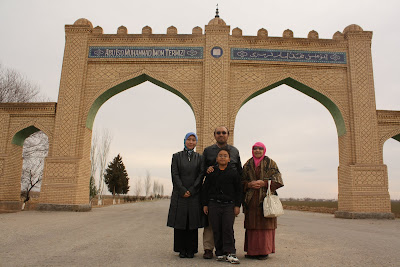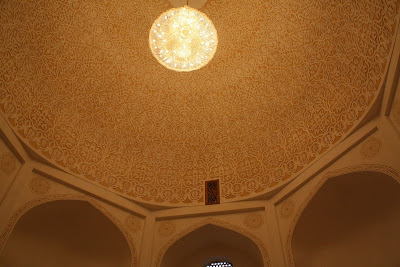Termez (or Termiz) is located in Southern Uzbekistan, by the Amudarya (also known as the Oxus River), near the border with Afghanistan. It is the capital of Surkhandarya Province and was once a great center of Buddhism and Islam.
The name "Termez" may have originated from the word "thermos", which means "hot" in Greek, supported by the fact that the city is the hottest point in Uzbekistan. Nevertheless, there are people who believe that the city's name has been derived from the word "taramato", which means "on the river bank" in Sanskrit.
In the early period of its existence, the main functions of Termez were to protect the Amudarya crossing and to service the caravans. During the Soviet invasion of Afghanistan (1979-1989), Termez was the primary transit point and became the base for over 100,000 Soviet troops. Today, the city acts as the main advanced post of Uzbekistan's southern border.
SOURCES:
Termez - An Ancient And Modern City At An Important Crossroads, Publishing-Poligraphic Share Company (Sharq), Tashkent, 2001.
http://en.wikipedia.org/wiki/Termez
The Mausoleum of Imam At-Termizi
~~~~~~~~~~~~~~~~~~~~~~~~~~~~~~~~
Imam At-Termizi (or At-Tirmidhi) is one of the great collectors of hadiths, a student (and also a teacher) of Imam Al-Bukhari. He was born in 824 AD in Bug and died in 892 AD in a place near Sherobod. His full name is Muhammad bin Isa bin Savra bin Musa bin az-Zakhkhak al-Sulami al-Khariyr al-Bugi at-Termizi. Being one of the great people of Termez, the imam is locally known as "Termez Ota" which means "Father of Termez City".
SOURCES:
Termez - An Ancient And Modern City At An Important Crossroads, Publishing-Poligraphic Share Company (Sharq), Tashkent, 2001.
http://en.wikipedia.org/wiki/Termez
http://en.wikipedia.org/wiki/Al-Tirmidhi
http://www.sunnah.org/history/Scholars/imam_tirmidhi.htm
http://en.wikipedia.org/wiki/Al-Tirmidhi
http://www.sunnah.org/history/Scholars/imam_tirmidhi.htm

The grand entrance to the Mausoleum of Imam At-Termizi.

The Mausoleum of Imam At-Termizi.

The Mausoleum of Imam At-Termizi.

The tomb of Imam At-Termizi.

The tomb of Imam At-Termizi.

The Mausoleum of Imam At-Termizi.

A memory with the keeper of the Mausoleum of Imam At-Termizi at the mausoleum's grounds.
The Architectural Complex of Al-Hakim At-Termizi
~~~~~~~~~~~~~~~~~~~~~~~~~~~~~~~~~~~~~~~~~~~~~
Al-Hakim At-Termizi is one of the famous Sufi leaders, who is recognized for his works in religious science and spiritual heritage. He was born between 750 AD and 760 AD, and died in 869 AD. His full name is Abu Abdullah Muhammad bin Ali bin Hasan bin Bashir Al-Hakim At-Termizi. Al-Hakim At-Termizi is another great personality of Termez, besides Imam At-Termizi, who is also locally known as "Termez Ota".
SOURCES:
Termez - An Ancient And Modern City At An Important Crossroads, Publishing-Poligraphic Share Company (Sharq), Tashkent, 2001.
http://en.wikipedia.org/wiki/Termez
http://en.wikipedia.org/wiki/Al_Khakim_At_Termizi
http://en.wikipedia.org/wiki/Al_Khakim_At_Termizi

A beautiful gazebo near the mausoleum of Al-Hakim At-Termizi.

The Mausoleum of Al-Hakim At-Termizi.

The interior of the mausoleum.

The interior of the mausoleum.

The fine design of a ceiling in the mausoleum.

The tomb of Al-Hakim At-Termizi.

The tomb of Al-Hakim At-Termizi.

The side view of the mausoleum.

An arch along the road leading to the Architectural Complex of Al-Hakim At-Termizi.
The Fayaz Tepa Monastery
~~~~~~~~~~~~~~~~~~~~~~~~
The Fayaz Tepa Buddha Temple Ensemble was built in the 1st - 4th Century AD, in the range of time when Buddhism became widespread in the Central Asia.
SOURCES:
Termez - An Ancient And Modern City At An Important Crossroads, Publishing-Poligraphic Share Company (Sharq), Tashkent, 2001.
http://en.wikipedia.org/wiki/Termez
http://www.orexca.com/termez.shtml
http://www.orexca.com/termez.shtml

The Fayaz Tepa from far.

The ruins of the Fayaz Tepa.
The sun-dried mud-brick walls were used to make the building stayed cool in the summer and warm in the winter.
SOURCES:
http://www.unesco.emb-japan.go.jp/htm/fayaztepa.htm
http://en.wikipedia.org/wiki/Mudbrick
http://en.wikipedia.org/wiki/Mudbrick

The ruins of the Fayaz Tepa.

At the dome of the Fayaz Tepa.
* All photos courtesy of Anvar Safarov.